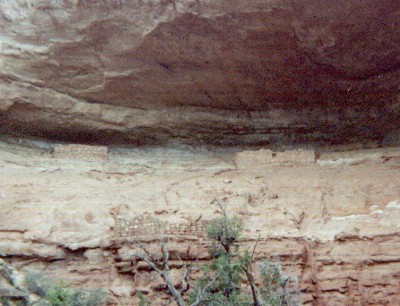 |
Sleeping Ute Mountain is prominent to the south of Sand Canyon. The weather is usually clear, but on this trip the skies were overcast and threatening. Mists gathered thickly about the peak of Sleeping Ute. Click on the image for an expanded view. |
 |
The trail starts out over slickrock, and passes a miniature butte near the trailhead. Behind the butte are the walls of a free-standing ruin, hidden among a grove of pinyon and juniper. |
 |
Sand Canyon is filled with almost perfectly arched alcoves, many of which contain ruins. The cliff in which this alcove is set comes to a flat, stubby peak, so that the formation as a whole resembles one of the adobe-brick ovens that the Pueblo Indians of the Rio Grande Basin call an horno (a Spanish word, pronounced "OR-no"). For this reason, Louise and I refer to it as "Horno Ruin", although this is not an official name, so far as I know. |
 |
The main trail is a 6 mile one-way trip, but sometime during the late 1990's a side-loop was added. This ruin is located along the side loop trail. Like the previous picture, we took the photo in 1999. |
 |
I snapped this shot of a lone, gnarled pinyon growing out of the top of a sandstone monolith, simply because the image appealed to me. Pinyons can look quite ordinary when they have plenty of growing room, but when they root in strange places like this, they twist themselves into natural bonsai. |
 |
This is a closeup of a two-level ruin. |
There's so much to see on this short trail, that I spaced out the photos over two pages, and even then left out many. You'll find a half-dozen more photos on page 2, along with directions to the trail.





